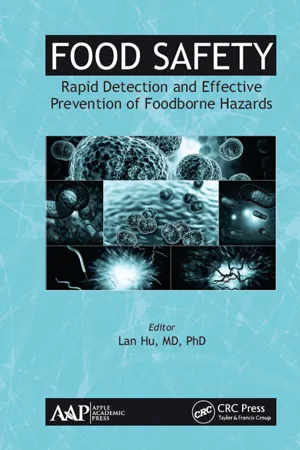
- 240 pages
- English
- ePUB (mobile friendly)
- Available on iOS & Android
About this book
This new volume, Food Safety: Rapid Detection and Effective Prevention of Foodborne Hazards, focuses on the general concepts, mechanisms, and new applications of analytical and molecular biology techniques for detecting, removing, and preventing chemical and biological hazards from food. Edited by a microbiologist and medical officer with over 20 years of laboratory and research experience in bacteriology, molecular biology, infectious disease, and food safety, and who has trained with the U.S. Food and Drug Administration (FDA), the volume provides an abundance of valuable information on food safety and foodborne hazards in our food and drink.
Today, food safety is a growing concern not only of food-related professionals and policymakers, but also of the public. Foodborne hazards, including chemical and biological hazards, can cause food intoxication, infectious diseases, cancers, and other health risks. Foodborne diseases are a major public health and economic burden in both the developed and developing countries. In the United States alone, the incidence of foodborne illness is approximately 9.4 million cases with about 56, 000 hospitalizations and 1, 351 deaths every year.
- Written in an easy-to-read and user-friend style, each chapter introduces a chemical or biological hazard and addresses:
- What kinds of disease does the foodborne hazard cause
- Why is it necessary for us to study it
- What routes does it take to enter our food and how does it cause us to become sick
- How do we identify it
- Chapters then go on to present new technologies employed to detect, isolate, and/or identify the hazard and prevention procedures such as: (ADD BULLETS)
- How can the current application of new technology be used to detect the foodborne hazards
- How do we prevent the diseases caused by the foodborne hazards
This book will be valuable to professionals and other specialists who work in food preparation, food safety, clinical laboratories, and food manufacturing industry. It will be a resource for food handling trainers as well as to anyone interested in foodborne hazards and their affective detection, reduction, and prevention strategies. This book can also serve as a important reference for more specialized courses in food safety-related courses and training programs.
Frequently asked questions
- Essential is ideal for learners and professionals who enjoy exploring a wide range of subjects. Access the Essential Library with 800,000+ trusted titles and best-sellers across business, personal growth, and the humanities. Includes unlimited reading time and Standard Read Aloud voice.
- Complete: Perfect for advanced learners and researchers needing full, unrestricted access. Unlock 1.4M+ books across hundreds of subjects, including academic and specialized titles. The Complete Plan also includes advanced features like Premium Read Aloud and Research Assistant.
Please note we cannot support devices running on iOS 13 and Android 7 or earlier. Learn more about using the app.
Information
Table of contents
- Cover
- Half Title
- Title Page
- Copyright Page
- Table of Contents
- List of Contributors
- List of Abbreviations
- Preface
- PART I: BIOLOGICAL TOXINS
- PART II: FOODBORNE BACTERIAL PATHOGENS
- PART III: FOODBORNE VIRUSES
- Index